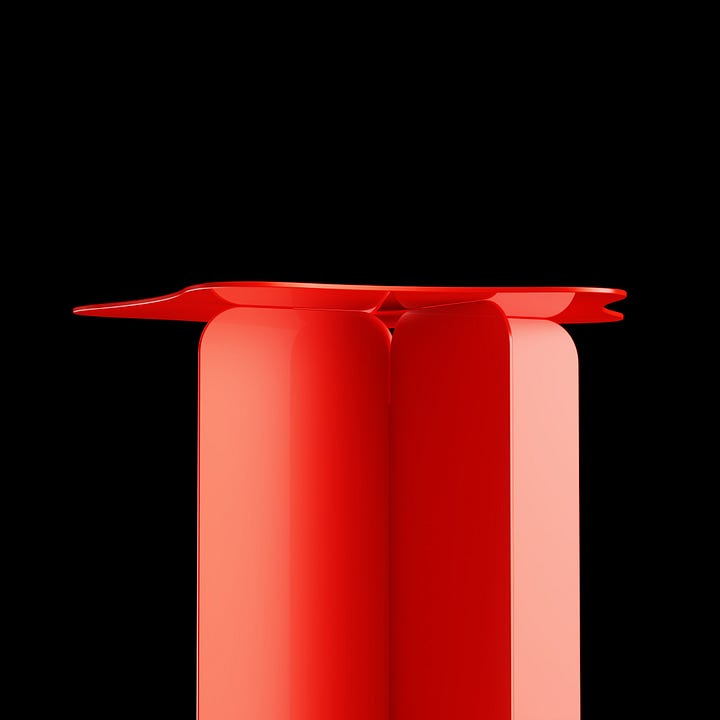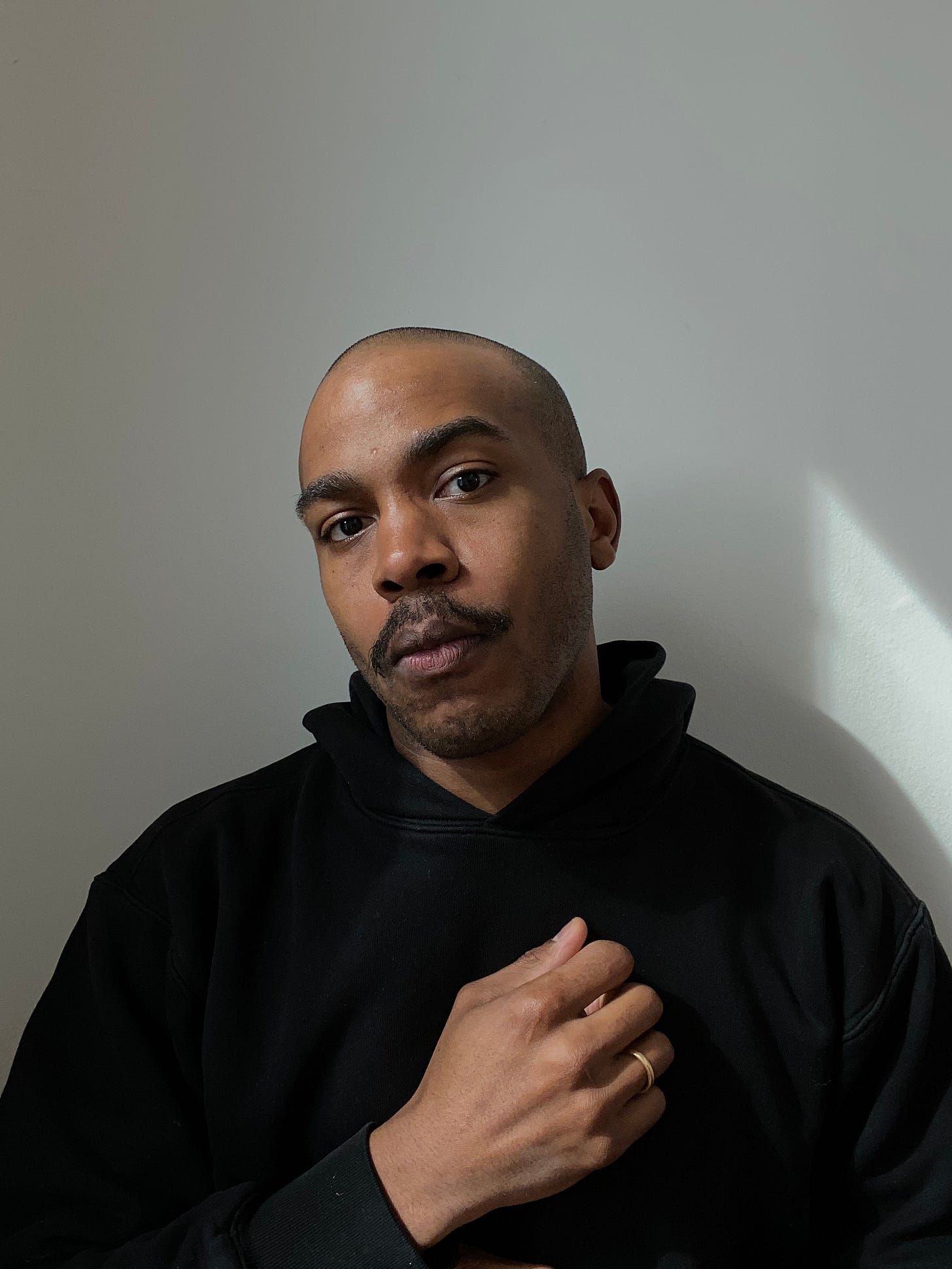Do It Your-SELF
Marvell Lahens's new line of made-to-order furniture invites the customer into the design process with a simple tool
One big takeaway from the height of the pandemic is that too much time indoors = interior design crisis. Like many of us stuck inside a smaller space for far too long than we’d like, I too underwent a year-long redesign of my apartment from 2020 into 2021, on the tiniest of budgets (I do love concrete blocks - they can be anything).
Judging from my research (Tiktok), many of you had a kind of reckoning as well. I saw people picking up new skills left and right, including an unexplainably high number of people who suddenly have full-blown rug tufting factories in their living rooms.
For AirBnB experience designer (and iterant audodidact) Marvell Lahens, a pandemic curiosity for furniture-making soon become much more than a temporary hobby. These experiments quickly led to metacognitive what-ifs: what if everyone could customize their furniture? What would it take to enable non-designers to, in fact, design?
Many questions and handheld CNC-ed explorations later, we have SELF™, Marvell’s new furniture line and proprietary design platform. A “radical experiment in empowering people to design their own furniture", SELF consists of a simple digital interface that allows the user to mix, match, and manipulate a basic side table form into a unique combination of original shapes, materials, and various color choices; the table is then fabricated and mailed to the customer.
It’s an ambitious idea, but the core philosophy is simple: meeting non-designers halfway and scaffolding the often daunting design process. It’s not a replacement for the work done by dedicated furniture designers crafting limited edition pieces from a singular vision, but more like a thoughtful and empowered alternative to the cookie cutter pieces we may find ourselves buying from certain unnamed furniture conglomerates. We’re curious and hopeful, eager to see what’s next 😊
I sat down with Marvell over Zoom to hear more about the project, the power of permutation, and the context of context itself.
The way that I like to interview designers to create a conversation, not just about furniture, but about your world—about you as a person.
I'll start with my favorite question: what's the most interesting thing you saw on the internet this week?
That's a great question. Probably something in the AI space. You know, there's so much happening every day. I don't play Roblox, but I saw that users can now to generate shapes and custom skins, using AI.
In terms of ubiquity, AI is pervasive. I think the fact that it's being applied by a younger audience, because of the accessibility, is so cool.
AI's been very front of mind for me this week—I have some side projects that use the Midjourney AI. It is interesting because a lot of people have a strong aversion to AI, because of the way it's been portrayed in our science fiction lore. Which isn’t invalid.
But the fact that it offers a new accessibility (especially to young people) to the creative world is exciting. With any new technology, there's always an element of fear involved, but to me the potential for creativity is promising.
A big theme in SELF™ is this idea of autonomy. I'm curious to know why you value autonomy, for people creating their own spaces? Living in a world ruled by West Elm and Ikea, where we’ve been encouraged to let our interiors be predetermined for us, why is autonomy important?
I'll give you some background: It was early in the pandemic—I was in Oakland and furniture brands did really well during the pandemic.
There was insight there for me: that people were at home, looking around and criticizing their spaces, realizing they might not have the ideal workspace for this extended period of time that they were about to embark on. They were realizing certain things that might not work in their spaces, or certain pieces that might be generic.
It got to the point where I just didn’t love anything in my space and so I started making stuff. We were lucky enough to have a table saw and the space to work in, so I started making furniture. And all of a sudden our home started to feel like this dynamic space that we wanted to be in, that we were okay being in for a long time.
I'm not a furniture designer per se—I'm not a crafts person actually—but I like making things really quickly and I like to partner with people to make a finished product. But eventually that all led to this question of how can I enable myself to repeat this process and how could that be applied for others.
So one way is with a CNC machine—I bought a handheld one. It's called the Shaper Origin.
A great name <laugh>.
Yeah <laugh>. Basically, if you can draw a vector in Adobe Illustrator or another vector program, then you can send that to the CNC and you can cut shapes. So I started with this idea that if you could create customizable shapes and then have those cut out, you could uplevel the quality and dynamism of your furniture.
How do you involve a non-designer or a non-maker in the design process? To feel like they're part of the design process without throwing them in the deep end? I realized early on that, even as a creative, a truly blank canvas is hard to work with. If this tool was gonna be accessible to everyone, not just designers, it had to be really simple to use, but with enough control to manipulate where you would feel like, “Okay, my signature is on it, because I am generating unique shapes.”
That insight was powerful to me: making design accessible by diminishing the barrier and lifting the veil around design, especially for the average consumer. It's the ability to express yourself visually—you can actually create that thing yourself. This is central to SELF—it’s in the name! <laughs>.
That's fantastic. It goes back to this idea of “What is a designer?” and how sometimes furniture should just be fun.


As a person who works full-time outside of SELF, how you balance your day job with your new adventure? What’s your relationship like with your primary job?
It ebbs and flows. At the core of it, the day job empowers and enables me to work on SELF from a financial standpoint.
For people who have a need to create, if the means or infrastructure aren't there, it's hard. So my day job keeps a roof over my head and allows me to pursue other passions. And it's not just SELF. It's fashion and objects I make.
Another element of this relationship with the day job is impatience. I think it's really easy to be impatient when you know what you want to be working on full-time. You have the insight, but you're not quite there yet, for whatever the reason.
And so I think I've come to terms with the short-term need, because I need a job. But as much as I need the day job, maintaining that North star is important: that I want to be working on my own ideas.
Totally. A lot of people are in the same boat, especially people who are making furniture, where they need to maintain a steady source of income and the structure of a nine to five.
I'm always curious to hear people's relationship to it. Many of my friends have been in that situation and I think it's an important conversation to have socially. It's a very normal experience. Very few people can afford to just leap into making furniture as their full-time career right away. It requires an intense amount of resources that many people don't have access to.
I've also seen a lessening in the stigma for artists, around this idea that if you're not “fully invested” in your art, you're not an artist. Maybe stigma is the wrong word, but there’s certainly this labeling of “selling out” if you have a job while you're also pursuing your art. But the job is stability and the reason you can actually create and have space, for me at least.
I would go so far as to say that engaging in these different disciplines benefits your creative work. You're not just in head-down, tunnel vision mode, but saying, “I'm gonna investigate everything that I'm curious about.” Some of the most talented and successful creative people I know are people who don't limit themselves to one discipline.
You mentioned fashion—what have you been working on in that space?
I recently had a transition from making fashion into focusing mostly on SELF, on the furniture. But in 2018, I had this idea to explore simple permutations of things that already exist.
What’s the one change that you could make to a shirt design that recontextualizes it, that redefines it? So that was my pursuit: again, not as a “fashion designer”, but exploring the avenues I can express myself in—the disciplines that are not native to me.
For me, it always comes down to permutations. What are the subtleties that make something new? Even if it's not necessarily a new invention.
It started with this common question: how to make the perfect t-shirt. For me, the question was, “Well, what's gonna be different about this? Is it materiality? Is it the weight? Is it the construction? What's my take on the t-shirt? What can I contribute to this canon that has long existed?”
The very first thing I ever made was a t-shirt with this incredible double knit construction cotton. It was a pocket T-shirt, and I just moved the pocket to the middle of the shirt. <Laugh> I was literally looking at a pocket shirt, thinking, “Why is it on the left?” That was the first thought experiment-turned-actual product.
But that change reconceptualized the shirt for me and for the consumer, [encouraging the user] to do something with it that they might not have previously done. For me, it's these considerations: How does changing the fabric or construction change the context of the piece itself?
That's a gem of a thought: when we adjust the context or we adjust our perspective, what happens? And that idea can be applied to furniture or fashion, anything.
There’s a big shift happening in the world of design: many people are going through an awakening in their relationship to furniture, much like you did. We like to use this phrase “new radical design” or “radical design subculture” in talking about the shift, which describes these distinct changes in the large industry and culture of design, like what happened in Italy in the late 60s and 70s.
It's now happening on both a macro and a micro scale across the world: people taking autonomy and ownership and excitement in their work, with new tools like AI. Even without studios, even without big companies.
Do you see this happening as well? How does it make you feel?
That's the big revolution that something like AI brings: anyone can do it. But of course, if anyone can do it, the question is, does that diminish the work? Does that mean everyone's an artist? Does that mean everyone's a designer?
Yes, the revolution is great. Yes, the revolution has created access and opened up the possibilities, but how do we continue to inject a human touch? What are the interruptions that we can put in front of technology? Let’s embrace technology, but maintain some element of humanity too.
But that's part of the revolution: accessibility and the enablement for everyone to partake in the design process.








